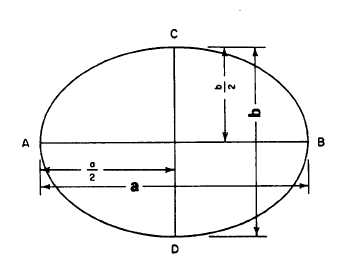Given an ellipse with major and minor axis of #a# and #b# find the area of the ellipse? Show your work. the perimeter of the ellipse is rather difficult to derive in closed form, discuss how you would approach it?
2 Answers
Explanation:

Let us consider an ellipse having center at origin
The equation of this ellipse can be written in the standard form
#x^2 / a^2 + y^2 / b^2 = 1# .......(1)
As the ellipse is symmetrical with respect to
Consider first quadrant only. Solving equation (1) for
#y = b sqrt(1 - x^2 / a^2 )#
retaining only#+ve# root for the quadrant of interest.
Area
#dA=b sqrt(( 1 - x^2 / a^2 ))cdot dx#
Area
#A/4=int_0^ab sqrt(( 1 - x^2 / a^2 ))cdot dx# ......(2)
Substituting in (2)
Using
#=>A/4=abint_0^(pi/2) cos^2tcdot dt#
Rewriting using the identity
#=>A/4=abint_0^(pi/2) ( cos 2t + 1 ) / 2cdot dt#
Evaluating the integral
#A/4 = 1/2 ab [ (sin 2t)/2 + t ]_0^( pi/2)#
#=>A/4 = 1/2 ab [ (sin pi)/2 + pi/2 ]#
#=>A/4 = (ab pi)/4#
In the given problem we have an ellipse with major axis and minor axis of lengths

Inserting given values in equation (3) we get
#A=pixxa/2xxb/2#
#=>A=1/4 piab#
Perimeter part follows.
Part 2. Perimeter of an ellipse.
Explanation:

As for area part of the question let us consider an ellipse having center at origin
The equation of this ellipse is written in the standard form
#x^2 / a^2 + y^2 / b^2 = 1# .......(1)
where it is assumed that#0 " < " b " < "a#
Now the ellipse can be represented by the parametric equations
#x=acostheta andy=bsintheta#
#0≤θ≤2π#
The ellipse is symmetrical with respect to
Length
#dp=sqrt(((dx)/(d theta))^2+((dy)/(d theta))^2)#
#:.p= 4int_0^(π/2)sqrt(((dx)/(d theta))^2+((dy)/(d theta))^2)cdot d theta#
#=>p= 4int_0^(π/2)sqrt(a^2sin^2theta+b^2cos^2theta)cdot d theta#
#=>p= 4int_0^(π/2)sqrt(a^2(1-cos^2theta)+b^2cos^2theta)cdot d theta#
#=>p= 4int_0^(π/2)sqrt(a^2-(a^2-b^2)cos^2theta)cdot d theta#
Multiplying and dividing with
#=>p= 4int_0^(π/2)asqrt(1-(1-b^2/a^2)cos^2theta)cdot d theta#
Let us define eccentricity of ellipse
#p= 4aint_0^(π/2)sqrt(1-epsilon^2cos^2theta)cdot d theta#
This is called an elliptic integral and unfortunately can’t be evaluated using standard functions.
We can make use of Binomial theorem to rewrite the integrand as a sum of infinite series. Note that this series converges for all values of
Explicitly we get the following expression
.-.-.-.-.-.-.-.-.-.-.-
We may also note that for a circle of radius
#p=2pia#

